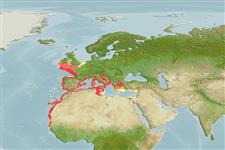Actinopterygii (ray-finned fishes) >
Pleuronectiformes (Flatfishes) >
Soleidae (Soles)
Etymology: Microchirus: Greek, mikros = small + Greek, cheir = hand (Ref. 45335).
Environment / Climate / Range
Ecology
Marine; demersal; depth range ? - 250 m (Ref. 4710). Temperate, preferred ?; 53°N - 12°N, 18°W - 30°E
Eastern Atlantic: Portugal southward to Senegal; a single record from southwest of the British Isles. Mediterranean: Spain, Algeria and Turkey.
Size / Weight / Age
Maturity: Lm ? range ? - ? cm
Max length : 40.0 cm SL male/unsexed; (Ref. 4710)
Short description
Morphology | Morphometrics
Dorsal
soft rays
(total): 71-86;
Anal
soft rays: 58 - 68;
Vertebrae: 40 - 43. Body oval; upper eye less than its own diameter from dorsal profile of head; anterior nostril on blind side not enlarged; anterior nostril on eyed side with a backward-pointing tube hardly reaching to front border of lower eye; dorsal fin beginning near vertical through front border of upper eye; pectoral fin on eyed side with 6-8 fin rays, on blind side shorter; caudal fin separate from last dorsal and anal fin rays; lateral line supra-temporal branch forming an angular S-shape, the ascending part running upward and backward (Ref. 4710).
Found on mud and sand of the continental shelf, from the shore down to 250 m (Ref. 4710). Feeds on small benthic invertebrates, mainly amphipods and polychaetes (Ref. 4710).
Life cycle and mating behavior
Maturity | Reproduction | Spawning | Eggs | Fecundity | Larvae
Desoutter, M., 1994. Révision des genres Microchirus, Dicologlossa et Vanstraelenia (Pleuronectiformes, Soleidae). Cybium 18(3):215-249. (Ref. 35940)
IUCN Red List Status (Ref. 115185)
CITES (Ref. 94142)
Not Evaluated
Threat to humans
Harmless
Human uses
More information
Common namesSynonymsMetabolismPredatorsEcotoxicologyReproductionMaturitySpawningFecundityEggsEgg development
ReferencesAquacultureAquaculture profileStrainsGeneticsAllele frequenciesHeritabilityDiseasesProcessingMass conversion
Tools
Special reports
Download XML
Internet sources
